 Jeff Sundin November 7, 2018 “Hunting the Hunt-Able My North Dakota Experience"
Jeff Sundin November 7, 2018 “Hunting the Hunt-Able My North Dakota Experience"
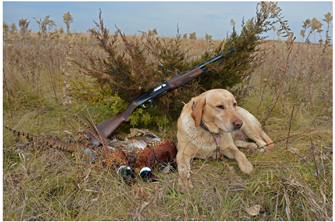 “You’re too early”, most folks told us. “The birds are still in the standing corn and it won’t be harvested this week, maybe not even next week either.”
“You’re too early”, most folks told us. “The birds are still in the standing corn and it won’t be harvested this week, maybe not even next week either.”
Those words turned out to be a fair assessment of what we found during our trip to North Dakota last week. Although there were a lot of farmers harvesting Soy Beans, Corn, for the most part was still standing.
Pheasants could be heard chattering from the innermost reaches of those huge corn fields. That made access a problem for us because hunters are not allowed to work in un-harvested crop fields. So most of the time all we could do was listen to the roosters cackling at us from a distance.
Ducks were largely off limits for us too, mostly because we were not equipped to hunt water and that's where most of the ducks were. Our addiction to field hunting for Mallards has led us to some really good experiences, but without access to harvested fields, our dependence on field hunting was a definite liability on this trip.
Then there’s the other big problem, gaining access to land that’s “hunt-able”. Even when we did see ducks feeding in a field where the crop had been harvested, we couldn’t get past the “No Hunting” signs posted along the boundaries.
 So we did what we do, turned our attention toward covering as many acres of public land that we could. At least wildlife management areas and waterfowl production zones provide accessible land. But accessible and “hunt-able” are two different things. Unless there are food plots planted within their boundaries or unless they are surrounded by recently harvested crop fields, most public areas holds few, if any Pheasants.
So we did what we do, turned our attention toward covering as many acres of public land that we could. At least wildlife management areas and waterfowl production zones provide accessible land. But accessible and “hunt-able” are two different things. Unless there are food plots planted within their boundaries or unless they are surrounded by recently harvested crop fields, most public areas holds few, if any Pheasants.
Ducks are scarce as hen’s teeth on most public lands too because there’s no food for them. The grass covered acres provide springtime habitat, but they are not going to attract ducks during the hunting season. So unless one can gain access to private ground, field hunting for ducks anywhere else is nearly impossible.
After our November 2014 trip to North Dakota, I wrote about cattails that were on fire, tiles draining small wetlands and tree rows being cut down. CRP funding was in decline, and thousands of acres were coming out of that program. Crop prices were high at the time too, so farmers, understandably so, were putting every square foot of land back into production. Learn More >> Destroying North Dakota Wildlife Habitat November 2014
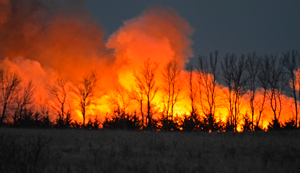 During the 4 years since my last visit, searching for “hunt-able” patches of earth hasn’t getting any easier. In fact, we drove to some of our “honey holes” of the past and found that they had completely disappeared. In one instance, an entire lake had disappeared and so had the entire habitat that used to surround it.
During the 4 years since my last visit, searching for “hunt-able” patches of earth hasn’t getting any easier. In fact, we drove to some of our “honey holes” of the past and found that they had completely disappeared. In one instance, an entire lake had disappeared and so had the entire habitat that used to surround it.
It was only natural that farmers wanted to maximize their profits by getting as much land into production as possible. But the problem was that modern farming practices made the process too easy. Within a couple of years, fields that used to have small wetlands, cattail sloughs and trees were drained, burned and cut down. Nowadays they’re planted, harvested and tilled from edge to edge, leaving little cover for anything to hide in, let alone provide food for critters to eat.
It was obvious that a lot of hunters had given up on the area where we like to hunt. Traffic at the motel was light, and instead of waiting for a table at the restaurant to buy our evening meal, we simply walked right in and sat right down.
Like us, the hunters who haven’t given up yet were still scratching their heads about where to find places to hunt. One obvious choice was to seek out “PLOTS” lands, Private Land Open to Sportsmen. These tracts of land were supposed to have been areas where we could hunt; I thought. But after driving to some of them and finding nothing but black dirt, we became a little frustrated.
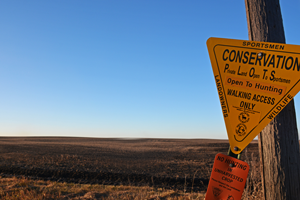 At first I wondered; “why not just staple up some no hunting signs like everybody else does? “At least that way we won’t get our hopes up when we see a spot on the map that’s supposed to be “hunt-able” land.
At first I wondered; “why not just staple up some no hunting signs like everybody else does? “At least that way we won’t get our hopes up when we see a spot on the map that’s supposed to be “hunt-able” land.
It was hard for me to imagine why this particular field was already harvested, tilled and neatly tucked away for winter, especially when there was so much un-harvested crop in the area.
At one stop I wondered if maybe this farmer, along with others were simply gaming the system. Enroll the land in the program, collet the cash and then make sure that there’s nothing to hunt. They get the goodies and we get nothing but black dirt.
“We used to get a lot of grief about that, especially in the early days of the program” said Kevin Kading, Private Lands Section Leader, North Dakota Game and Fish Department. “It’s not always easy to see, but if there’s a parcel in the program, there’s a good reason for it.”
What I learned during my chat with Kevin is that not all PLOTS lands are equal. Yes, they do provide access to hunters, but that is not the primary mission of the program; preserving habitat is. In fact the PLOTS program actually began 20 years ago as a way of augmenting the CRP program.
In those days farmers who received payments under the CRP program were still required to pay the expenses for seeds, preparation and planting. The PLOTS program allowed farmers to re-coup some of those expenses, with a few strings attached. One of those strings was to grant hunters walk in access to CRP lands that were previously off limits.
The scope of the PLOTS program varies from parcel to parcel and no two projects are alike.
Let’s say that the field of black dirt you see in the image on the right was enrolled in the program to protect one small cattail slough located way over the hill and around the corner. Even though we may not see it from the road, that cattail slough is out there and for wildlife, it’s valuable. The value is relative though and in this case the farmer may receive very little in the way of cash from the program. Still, once the parcel is enrolled in the program, that cattail slough must be protected for the life of the agreement.
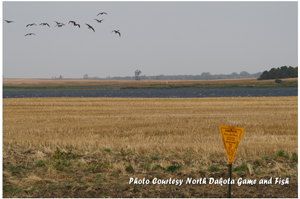 At the other extreme, a farmer who’s willing to enroll a large parcel of land that contains prime wildlife habitat could receive much larger annual payments, ones that approach the “fair market” rental value of crop lands in that region.
At the other extreme, a farmer who’s willing to enroll a large parcel of land that contains prime wildlife habitat could receive much larger annual payments, ones that approach the “fair market” rental value of crop lands in that region.
Valuation of parcels in the program is all over the map. Payments could range anywhere between .50 cents per acre for a marginal project, to upwards of $100.00 per acre to protect a tract of prime habitat. “The agreements are established on a case by case basis. We interview each landowner, establish goals for the parcel, calculate a value and form an agreement.” Kading said.
In North Dakota, sales of hunting licenses provide almost the entire $17 million bi-annual budget. The federal excise taxes on shooting and hunting gear provides an additional stipend, but there are no funds allocated in the general state budget. About $6 million per year goes to “public access” projects, while $2.5 million is devoted to annual “non-access” project expenditures.
North Dakota PLOTS enrollment is currently 762,000 acres, down from its 1.1 million acre peak in 2007.
Since 2013, crop prices have fallen and there’s renewed interest about PLOTS on the part of some farmers. Still, it all boils down to cash and the supply of it is far from adequate.
It seems like my $246.50 worth of North Dakota hunting licenses should be enough to cover the 8 roosters I bagged. But I’m afraid it's just a drop in the bucket and that they could use a lot more.
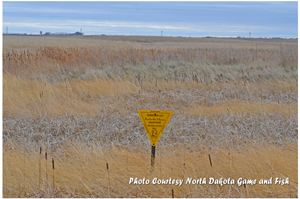 Truthfully, I would pay more too, especially if I could be assured that it would lead to more opportunity for us to access “good” hunting land.
Truthfully, I would pay more too, especially if I could be assured that it would lead to more opportunity for us to access “good” hunting land.
I’m glad that I took the time to learn more about the PLOTS program. At least now I have a better understanding of how it works.
I won’t be so quick in jumping to conclusions about what motivates folks in the program either. The next time I arrive at a plowed field of black dirt, I won’t assume that it means there’s a farmer who’s “gaming the system”.
It’s obvious to me that folks like Kevin Kading are doing the best they can with what they have to work with. And while I’m certain that finding great hunting spots won’t necessarily be guaranteed because of walk in access granted by farmers enrolled in the program. At least there is hope, it's nice to believe that a handful of these spots might just become glorious fields of chest high grass, filled with roosters. ![]() - Jeff Sundin 218-245-9858 or EMAIL
- Jeff Sundin 218-245-9858 or EMAIL
More ways to connect! Sign up to receive the Free "Insider Newsletter". Don't forget, you can always catch up with Jeff Sundin on the radio program too! Listen every Thursday at 6:20 AM and get additional fishing reports and information. KAXE 91.7 FM Grand Rapids - 105.3 FM Bemidji - 89.9 FM Brainerd . Want even more? Get HANDS ON Fishing Tips. Book your own Guided Fishing Trip ! |